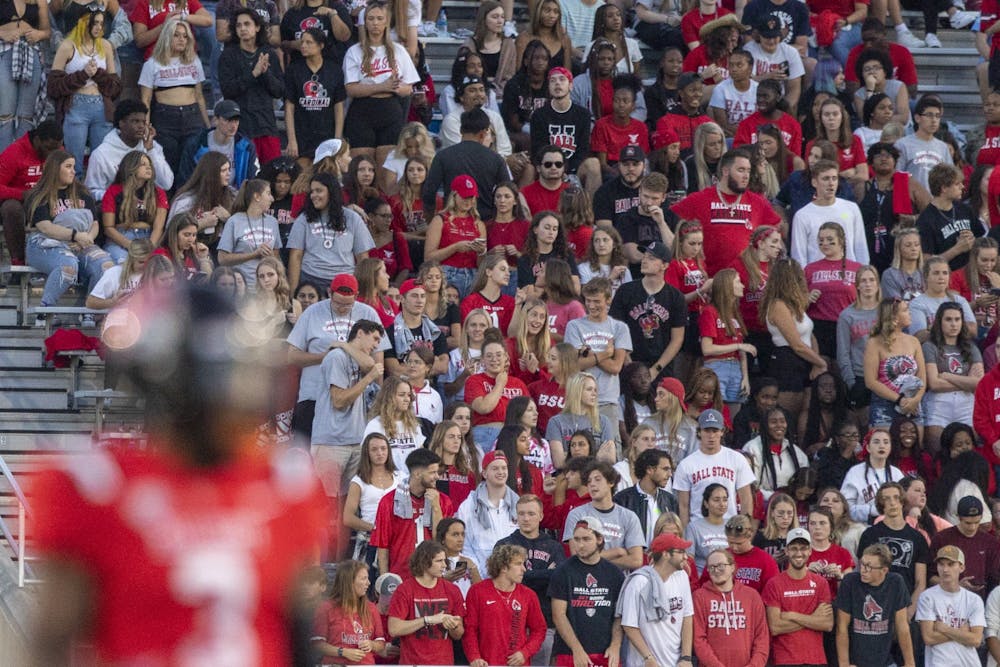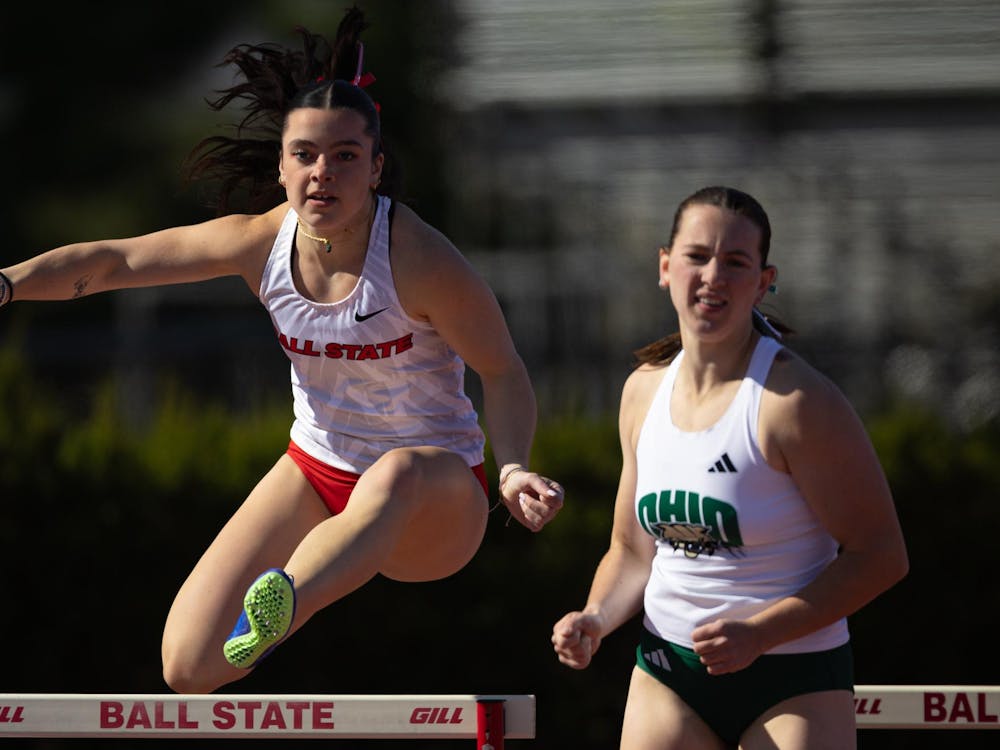Charleston Bowles is a junior journalism magazine media major and writes columns for The Daily News. His views do not necessarily reflect those of the newspaper.
It’s no secret having fans back in the crowd has helped Ball State Athletics. It’s fulfilling for me to attend home games once again both as a student and reporter for The Daily News.
After Ball State Football’s season-opening 31-21 victory against Western Illinois Sept. 2, head coach Mike Neu said it was extremely fulfilling to play in front of a packed Scheumann Stadium again. This game was my first in the press box covering football for The Daily News, and I witnessed the electric atmosphere firsthand.
"Just to see the fans warming up, going through their routine, to see the tailgate area, all the food trucks outside — it’s so cool to see that” Neu said. “And, as people walked into the stadium, just to get that vibe and energy, I loved that so much for our players. I know how hard they’ve worked, and that would mean more to them than anything.”
During the 2020-21 academic year, Ball State Athletic teams played shortened schedules and hosted games in front of few — if any — fans due to COVID-19 concerns, and this significantly changed not only how fans interacted and supported the teams but how engaged they were with the season overall. Last year, Ball State Football played a six-game, Mid-American Conference-only regular season schedule instead of its normal 12-game slate. Instead of hosting their standard six home games, the Cardinals hosted just three. I wasn’t able to attend any of the three because the first two were played during weekdays while the third occurred after classes had already gone fully virtual between Thanksgiving and winter break.
Last year, Ball State Football played a six-game, Mid-American Conference-only regular season schedule instead of its normal 12-game slate. Instead of hosting their standard six home games, the Cardinals hosted just three. I wasn’t able to attend any of the three because the first two were played during weekdays while the third occurred after classes had already gone fully virtual between Thanksgiving and winter break.
Meanwhile, Ball State Women’s Volleyball, which usually plays its season in the fall, had its season pushed back to January as a result of the pandemic’s impact. Similar to football, they played a MAC-only schedule and finished with a 4-7 record in Worthen Arena.
Other fall sports, such as soccer and field hockey, also had their 2020 campaigns pushed back to last spring and either had no postseason or a compact MAC tournament.
These postponements impacted both my fandom as a student and work as a reporter because I never knew the status of Ball State teams. I didn’t know if coaches and players were inactive due to COVID-19 exposure or if certain games would be the last for a while because of quarantine and close contact policies.
Fast forward to fall 2021, and Ball State Women’s Volleyball has surpassed its home win total from last season, sitting 7-0 at Worthen Arena with four home matches remaining. Ball State Football drew 14,902 fans in its MAC opener against Toledo Sept. 25, a higher turnout than all but one of its six home games in 2019.
While the return of full crowds has clearly been beneficial for Ball State Athletics, it has had just as much of an impact for fans and students. Junior business analytics major Steven Willeke said he considers himself an avid sports fan and attended two of the first three home football games this season, including the season opener.
“The energy was there week one — that thing was packed,” Willeke said. “I remember I even got a free T-shirt, so I was pretty hyped. I'll be walking around campus, and I see people wearing that same shirt. I get this might sound cheesy, but that made the experience. I got a free shirt out of it, and I got to watch some good football.”

Willeke attends Indianapolis Colts and Indiana Pacers games regularly. Even though Willeke is used to larger stadium environments, he said, he prefers the Ball State setting because it's easier to socialize and meet new people while also watching the game.
It felt great to be back in Scheumann Stadium, even if it wasn’t as a fan. I didn’t get to experience the football program's path to winning the 2020 MAC Championship and Arizona Bowl, so I appreciated the chance to attend games in person without restrictions.
But while football and women’s volleyball headline the fall sports season, programs such as field hockey and soccer see smaller attendance numbers. Ball State Soccer’s largest draw this season came Sept. 12 against Butler, which saw 206 fans. Field hockey's highest-attended matches were Sept. 26 against Indiana University and Oct. 8 against Appalachian State, with each one drawing 125 fans.
Before I joined The Daily News the second semester of my freshman year, I only attended football and basketball games. I grew up playing those sports and didn’t know much about sports like soccer, field hockey and others which contribute to the diversity of Ball State Athletics. I was hesitant to attend these games because I had no connection to them, other than that they were played at Ball State.
Although he’s never been to a Ball State athletic event outside of football or men and women’s basketball, Willeke is eager to attend smaller sporting events this year. He said he hopes Ball State can create more of an inviting atmosphere for these events, similar to the football and basketball games.
The inviting atmosphere at football and basketball games includes jumbotrons, as well as interactive events at timeouts, end of quarters and halftime where students can participate in games to win prizes.
“For me, I mainly watch three sports: football, basketball and baseball,” Willeke said. “I want to feel more connected to the sport because I don’t know much about sports like soccer. I want to have a reason to go and support the team.”
I feel Willeke’s eagerness as well. I had the opportunity to cover soccer and men’s and women’s swimming and diving during the 2020-21 academic year but did not attend the events in person. Instead, I scoured athletic websites for live streams and followed a stat tracker throughout each event. However, this season, I’m now able to go to these smaller-attended events and experience the action up close.
Ball State Athletics can improve at marketing these smaller programs and advertising them across campus, social media and other avenues accessible to students. Athletes should have the ability to participate in social media takeovers and bring the fans into their daily routines, which could include practices, team meals and even game preparation.
Students should know the premier players within the smaller programs, their backgrounds and stories before coming to Ball State. If students have a better understanding of who’s representing the Cardinals in soccer and field hockey, they will likely be more inclined to attend games and follow the team closely. The followers of soccer and field hockey should not feel any less significant than those of football and volleyball. With students able to get in free to all home athletic events, the attendance numbers for these sports are more disportionate than they should.
As we enter the new era of the NCAA’s name, image and likeness policy, the financial gap is already beginning to grow between larger and smaller sports on each campus. Ball State Football redshirt fifth-year quarterback Drew Plitt, redshirt fifth-year Justin Hall and redshirt senior running back Will Jones all have NIL deals in place because of the popularity and high demand of football. Meanwhile, no soccer or field hockey players have deals — which we as fans can’t determine because of the attention larger sports have traditionally received.
However, as a Ball State community, the least we can do is provide more support by attending these smaller sporting events on campus, providing them with the same energy we give at basketball, football and volleyball games.
Contact Charleston Bowles with comments at clbowles@bsu.edu or on Twitter @cbowles01.





